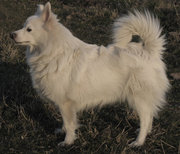 German Spitz
German Spitz|
From Wikipedia the free encyclopedia, by MultiMedia |
Spitz-type breeds of Dog (the correct German plural is Spitze, though Spitzen is commonly used in the US) are characterised by long, thick, and often white fur, and pointed ears and muzzles. The tail is usually curled over the Dog's back.
The exact origins of spitz-type Dogs is not known, though most of the spitz-types seen today originate from the Arctic regions.
There is no archaeological evidence showing transition stages between the wolf and the often-similar spitz-type Dogs. Skeletal remains up to 5,000 years old suggest it is far more likely that the ancestors of spitz types mated with wolves.
Though it is not completely certain that there has been wolf blood in the spitz-type Dogs for that long, it is certain the humans have intentionally mated spitz types with wolves in more recent times to achieve the wolf-like appearance of breeds such as the Alaskan Malamute.
About three thousand years ago, Dogs began to migrate from the Arctic into temperate Europe, North America, Asia, and to a lesser extent, Africa.
Skeletal remains around 2,000 years old unearthed in Switzerland indicate that spitz-type Dogs have inhabited Central Europe for millennia. These Dogs are almost certainly the ancestors of the European spitz-types, such as the Keeshond and Schipperke.
Many spitz-types also migrated into Korea and China. Over the centuries, many of these Dogs were transported by humans to Japan, most likely from Korea. These Asian spitz types are the ancestors of today's breeds such as the Chow Chow and the Akita Inu.
Through selective breeding, spitz types have evolved to fit three purposes helping humans: hunting, herding, and pulling sleds.
The larger and more powerful breeds such as the Karelian Bear Dog and the Norwegian Elkhound were used for big game hunting, helping humans kill moose and elk.
Smaller breeds such as the Finnish Spitz and the Lundehund were used in Scandinavia to hunt birds and smaller mammals.
The largest of all the spitz types, notably the Canadian Eskimo Dog and the Greenland Dog, were used to pull sleds up until the 19th century. During that century, when fur trapping became a lucrative business, people began to realise that size did not necessarily relate with endurance, and the smaller Siberian Husky came to be used more frequently in Canada and Alaska. The Finnish Lapphund was used by the Sami people.
Spitz types are well suited to living in harsh northern climates. They often have an insulating, waterproof undercoat that is denser than the topcoat to trap warmth.
Small ears help reduce the risk of frostbite and thick fur grows on the paws to protect the Dogs from sharp ice.
However, many spitz-type breeds retain wolflike characteristics such as excessive independance, suspiciousness, and aggression towards unfamiliar humans or other animals, and can therefore require much training before they become manageable. Some, such as the Karelian Bear Dog, are almost impossible to train as companion Dogs.
The charming look of the spitz-type, with its thick fur, fluffy ruff, curled tail and small muzzle and ears, have caused several people to create non-working types designed to be companions or lap Dogs. This trend is most evident in the tiny Pomeranian, which was originally a much larger Dog closer to the size of a Keeshond before being bred down to make an acceptable court animal.
Other spitz types which have been bred away from working uses are the American Eskimo Dog, the Alaskan Klee Kai, the German Spitz and possibly even the Papillon.
This list might not be complete and is, at best, an educated guess from experts and Dog fanciers based on the physical characteristics of the breeds. Some, such as the Papillon, exhibit the tail, coat, and head of a Spitz Dog, but its ears more closely resemble spaniels although being upright like the Spitz. In the future, genetic studies might better clarify the relationship among various breeds. Note that Dogs listed here might also be classified as toy Dogs, herding Dogs, sled Dogs, and in other types.